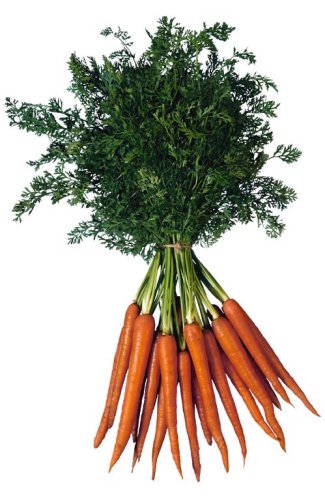Growing Carrots
Organic Vegetable Gardening
Fact Sheet
Botanical name: Daucus carota
Seed |
|
||
| Planting time: | SP,SU,FA | ||
| Seeds per ounce: | 19000-25000 | ||
| Ounces per square foot: | 0.002 | ||
| Minimum legal germination rate: | 55% | ||
| Germination type: | |||
Notes Carrots are a hardy, cool season crop that can be planted in your organic garden as soon as the soil can be worked in the spring. Carrots require hefty amounts of moisture and are not tolerant of drought. Prolonged hot weather may not only retard growth, but result in an undesirable strong flavor and coarse roots. The method I use for growing Carrots is as follows:
This is intercropping and works every time for Growing Carrots. Within a week your Radishes will germinate first and by the time your carrots begin to germinate and grow you will be harvesting your Radishes making room for your Carrots. |
|||
Planting |
|||
| In garden spacing (inches): | 3 | ||
| In flat spacing (inches): | Broadcast | ||
| Planting depth (inches): | Cover seed with soil | ||
| Maximum number of plants per square foot: | 25 | ||
| Nutrient relationship:: | Light Feeder | ||
Harvest |
|||
| Days to maturity: | 63-77 | ||
| Harvesting period (days): | 28 | ||
| Minimum yields in pounds /square foot: | 1 | ||
Cultural |
|
| Diseases: | Aster Yellows, Black Root Rot, Cotton Root Rot, Damping-Off, Growth Crack, Leaf Blight, Leaf Spot, Powdery Mildew, Root Knot Nematode, Southern Blight. |
| Insect pests:(Insect Pest Finder) | Beet Armyworm, Carrot Beetle, Carrot Rust Fly, Carrot Weevil, Eastern Field Wireworm, Fall Armyworm, Leafminer, Parsleyworm, Tarnished Plant Bug, Vegetable Weevil, Vegetable Weevil, Yellow Woollybear |
Varieties |
|
Small, Round Carrots 'Orbit' - good color, few off-types, and best harvested at the size of a 50 cent piece) 'Thumbelina' - round roots; good for planting in containers and in heavy, shallow, or rocky soil) Baby Carrots 'Baby Spike' - 3 to 4 inch roots, 1/2 inch thick; excellent internal color; tender; holds small size well) 'Little Finger' - tiny tender roots; 5 inch roots, 1/2 inch thick; golden orange, sweet, and crisp) 'Minicor' - slender fingerling carrots; colors early; uniform, cylindrical, blunt tip; good flavor) 'Short ‘n Sweet' - rich, sweet flavor; 4 inch roots, broad at shoulder, tapered to a point; good for heavy or poor soil) Chantenay Carrots 'Red-Cored Chantenay' - heavy yield; good flavor; short, thick roots, broad at the shoulder, tapered to blunt tip) 'Royal Chantenay' - broad-shouldered, tapered roots; bright orange; good for heavy or shallow soils) Danvers Carrots 'Danvers Half-Long' - uniform, 7 to 8 inch roots tapered to very blunt end; sweet, tender) 'Danvers 126' – has heavier yield than Danvers; smooth roots; tops withstand heat). Nantes Carrots 'Nantes Coreless' - orange-red; small core, medium top) 'Scarlet Nantes' - bright orange, slightly tapered, 6 inch roots; crisp, tender and flavorful; standard for high quality carrots) 'Touchon' - interior, exterior bright orange; 7 inch roots, nearly coreless) Imperator Carrots 'Gold Pak' - 8 inch roots, 1-1/2 inches thick; sweet, tender, as coreless as any; good for juice) 'Imperator 58' - smooth, fine-grained, long, tapered roots; standard long, thin type) 'Tendersweet' - long, tapered roots; rich orange color; sweet, coreless) Novelty Carrots 'Belgium White' - mild flavor; long, tapered, white roots; productive, vigorous) |
|
Organic Gardening Seed and Plant Sources:
Return to Organic Gardening Vegetables from Growing Carrots




Comments
Have your say about what you just read! Leave me a comment in the box below.